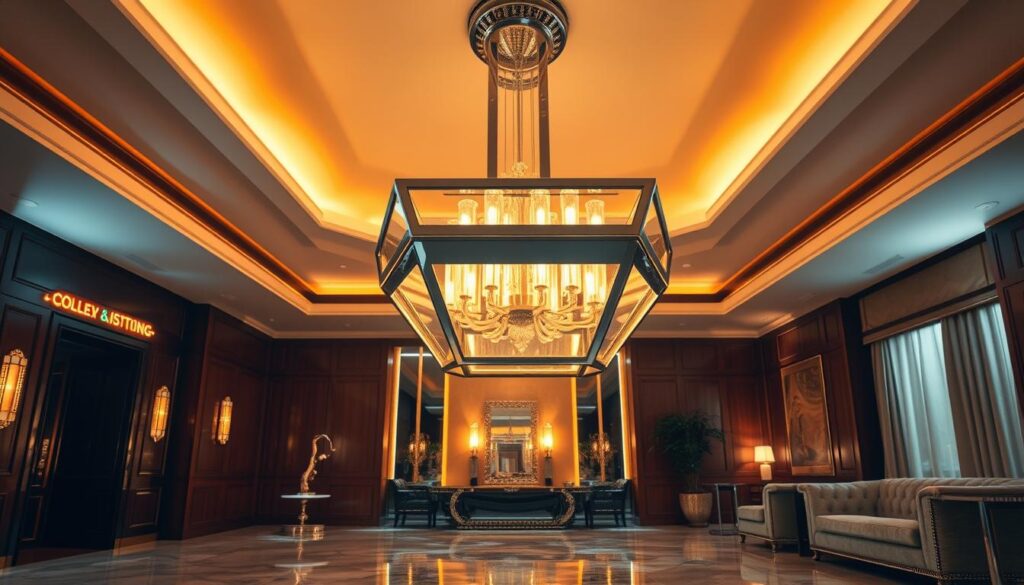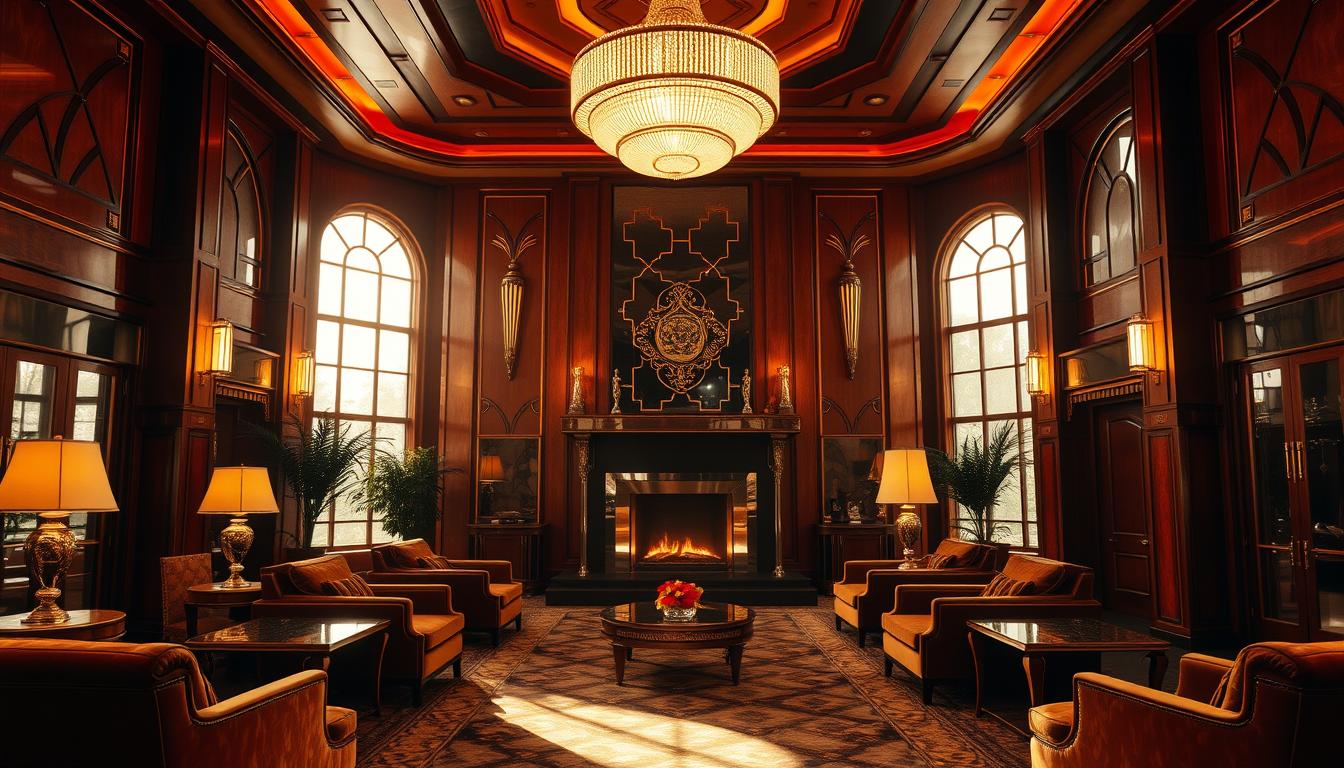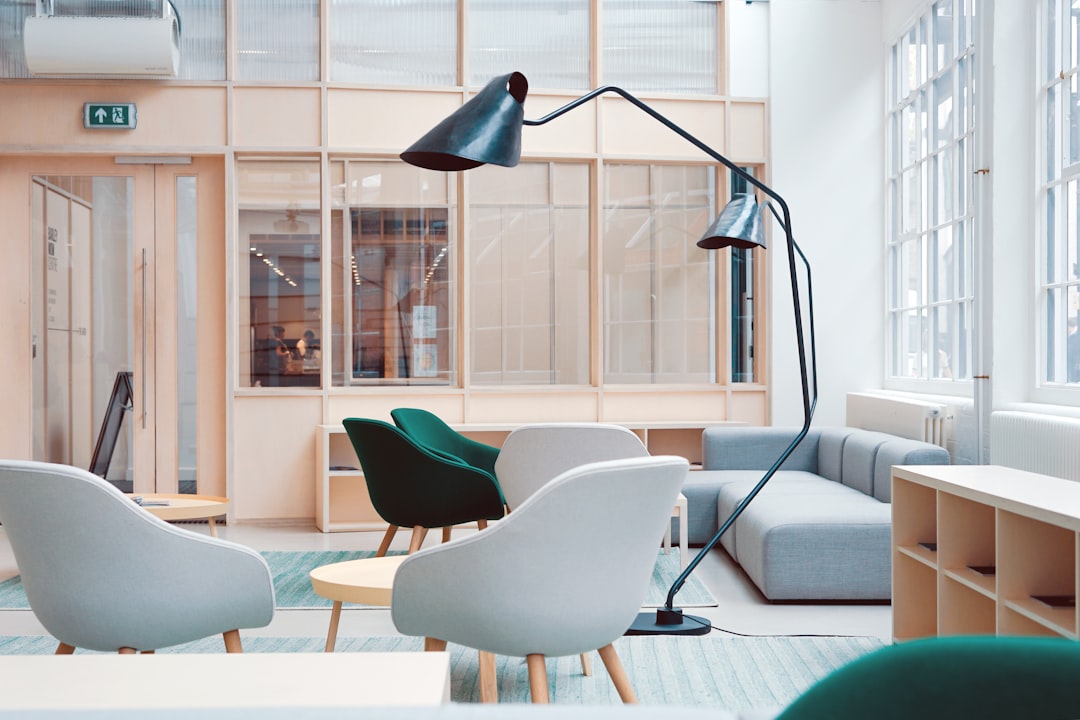Art Deco started in the 1920s and still shapes interior design today. It’s known for its luxury and glamour. We see this in geometric shapes, metallic finishes, and bold colors.
Art Deco design is all about luxury and glamour. We add these elements to our spaces for a chic, sophisticated vibe. By using luxe materials, atmospheric lighting, and stylized motifs, we bring Art Deco into today’s homes.
Key Takeaways
- Art Deco style is characterized by geometric shapes and metallic finishes.
- Luxe materials and atmospheric lighting are key elements of Art Deco design.
- Combining bold colors and stylized motifs creates a sophisticated look.
- Art Deco can be incorporated into modern homes through the use of luxe materials and metallic accents.
- Mixing Art Deco with other styles can create a unique and glamorous interior space.
Understanding the Art Deco Style
Art Deco is a design movement from the 1920s to the 1940s. It’s known for its geometric shapes, metallic materials, and ornate decoration. This style is both luxurious and modern.
Key Characteristics of Art Deco
Art Deco stands out with its geometric shapes like triangles and circles. It also uses metallic materials like chrome and gold. For more on Art Deco interior design, check out Robern’s article.
- Geometric patterns and shapes
- Metallic materials and bold colors
- Ornate decoration and luxurious finishes
These elements make Art Deco both opulent and modern. It’s a favorite for adding glamour to spaces.
Colors and Materials Used
The colors of Art Deco are bold, with shades of black, white, and metallic. It uses exotic woods, ivory, and precious metals for a luxurious look.
Common materials used in Art Deco include:
- Exotic woods like ebony and mahogany
- Precious metals such as gold, silver, and chrome
- Luxurious fabrics like silk and velvet
Historical Context
Art Deco started in the Roaring Twenties, a time of big cultural and social changes. It was a way to bring optimism and glamour after a period of austerity. Knowing its history helps us see its lasting impact on design.
Understanding Art Deco’s history shows its importance and ongoing influence on modern design.
The Evolution of Art Deco Design
Art Deco has changed over time, showing the tastes of each era. It started in the 1920s with shapes, metals, and fancy designs.
Origins in the 1920s
The 1920s were the birthplace of Art Deco. It was all about modernity and the industrial age. It featured bold shapes, luxurious materials, and a touch of luxury.
Art Deco first appeared in buildings, furniture, and art. It made skyscrapers, chairs, and accessories look fancy. It also linked to Hollywood glamour and the rich lifestyle.
Modern Adaptations
Over the years, Art Deco design has evolved. It now mixes old and new, using modern materials and tech. This makes it look fresh and elegant.
Now, luxury Art Deco interior design includes many elements. Think of fancy lights, detailed patterns, and shiny metals. Designers keep the original Art Deco spirit alive while adding new twists.
Cultural Influences
Many cultures have shaped Art Deco over time. It has taken on Egyptian, Asian, and African styles, making it richer. This mix of cultures has made Art Deco more interesting and diverse.
Today, Art Deco inspiration comes from all over the world. This keeps the style alive and exciting. It shows how Art Deco can adapt and stay relevant across cultures and time.
Elements of Art Deco in Interior Design
Art Deco interior design is all about luxury, glamour, and modernity. It’s perfect for those who want a sophisticated living space. This style is popular for its elegance and style.
Geometry and Symmetry
Geometry and symmetry are key in Art Deco design. Shapes like triangles, circles, and zigzags bring balance and harmony. Symmetry is achieved with mirrored furniture and balanced patterns.
For example, a room might have symmetrical lamps on either side of a sofa. Or, a geometric rug adds interest. Use geometric-shaped decorative items and symmetrical furniture arrangements to get this look.
Luxurious Materials and Finishes
Luxurious materials and finishes are a big part of Art Deco. Marble, chrome, and exotic woods add opulence and sophistication. High-gloss finishes and metallic accents make a room feel glamorous.
To add luxury, use marble countertops, chrome lighting fixtures, or exotic wood furniture. For more ideas, check out retro lounge interior design ideas.
| Material | Characteristics | Use in Art Deco |
|---|---|---|
| Marble | Luxurious, elegant, and sophisticated | Used for countertops, flooring, and decorative accents |
| Chrome | Modern, sleek, and reflective | Used for lighting fixtures, hardware, and decorative accents |
| Exotic Woods | Rich, luxurious, and unique | Used for furniture making and paneling |
Bold Patterns and Textures
Bold patterns and textures are key in Art Deco. Geometric patterns and metallic textures add interest and depth. These can be used in furniture, rugs, and accessories.
To add boldness, use geometric patterned rugs, textured throw pillows, or metallic wallpaper. This creates a dynamic interior that captures the Art Deco spirit.
Choosing a Color Palette for Art Deco Spaces
Choosing the right colors is key to capturing Art Deco’s essence in your design. Art Deco is known for its bold, glamorous, and sophisticated colors. These colors help create a luxurious feel.
Popular Color Combinations
Art Deco color palettes mix bold and metallic colors. Some top picks include:
- Black and gold for a dramatic, luxurious feel.
- Soft pastels with metallic silver or chrome for a softer look.
- Bold contrasts like navy blue and bright red for energy and vibrancy.
These combos work well on walls, furniture, and accessories. They help create a stylish, cohesive space.
Incorporating Metallics
Metallic colors are a big part of Art Deco, adding luxury and glamour. To use metallics well:
- Apply metallic paints or finishes on furniture and accessories.
- Add metallic accents through lighting, vases, and decorative items.
- Balance metallics with neutral colors to avoid overwhelming the space.
Elsie de Wolfe, a design pioneer, said, “The art of decorating is not just about pretty things. It’s about creating a harmonious whole.”
“The modern art deco style is not just about looks; it’s about creating an atmosphere that shows your personality and style.”
Creating Contrast with Shades
Contrast is vital for visual interest in Art Deco spaces. Mixing different shades adds depth and sophistication.
| Color Combination | Effect |
|---|---|
| Light and Dark Shades | Creates a dramatic contrast that draws the eye. |
| Monochromatic with Accents | Adds depth and visual interest through subtle variations in tone. |
| Complementary Colors | Produces a vibrant and energetic atmosphere. |
By picking a color palette with Art Deco favorites, metallics, and contrasting shades, you can make a sophisticated, glamorous space. It will truly capture the spirit of modern Art Deco design.
Selecting Furniture with Art Deco Inspiration
Finding the right furniture is key to an Art Deco-inspired room. It should feel luxurious and elegant. The right pieces can make your space feel both vintage and modern.
When picking furniture, think about Art Deco’s main features. Look for geometric shapes, luxurious materials, and bold patterns. Iconic Art Deco furniture pieces often have inlaid woods, metallic accents, and exotic materials. These reflect the era’s luxury.
Iconic Art Deco Furniture Pieces
Some iconic Art Deco furniture includes:
- Console tables with mirrored surfaces and geometric patterns
- Sofas and armchairs with sleek, curved lines and luxurious upholstery
- Coffee tables featuring inlaid woods and metallic accents
- Cabinetry with bold, geometric patterns and exotic materials
These pieces capture the glamour of the Art Deco era. They add sophistication to any room.
Sourcing Authentic Pieces
For authentic Art Deco furniture, try vintage shops, estate sales, and online marketplaces. Antique shops, estate sales, and online marketplaces are great places to find original pieces.
When buying vintage, check the condition and history. You might need to restore it to its former glory.
Balancing Vintage and Modern
Mixing vintage Art Deco furniture with modern pieces creates a unique space. The goal is to find a balance. Each piece should enhance the others.
| Vintage Element | Modern Counterpart | Design Effect |
|---|---|---|
| Ornate, inlaid wooden cabinet | Sleek, minimalist sofa | Contrasting textures and styles create visual interest |
| Geometric-patterned vintage rug | Modern, monochromatic wall art | Blends traditional patterns with contemporary aesthetics |
| Art Deco-style console table | Modern, sculptural lighting fixture | Combines vintage elegance with modern flair |
By mixing vintage and modern, you can make a space that’s both nostalgic and modern.
Lighting Design with Art Deco Flair
In Art Deco interiors, lighting is more than just a need; it’s a showstopper. It’s a key part of Art Deco design, making a space pop and adding flair. We’ll look at how to light up your Art Deco-inspired rooms just right.

Statement Lighting Fixtures
Art Deco is all about bold lighting. These pieces often have shapes, metals, and fancy details. To add Art Deco flair, pick lights with striking, sculptural designs.
- Chandeliers with crystal or glass drops
- Sconces with metallic finishes like chrome or bronze
- Table lamps with geometric shapes and inlaid materials
When picking these lights, make sure they fit with the room’s style. This way, the lighting will enhance the space without taking over.
Layering Light Sources
Layering lights adds depth and interest to a room. In Art Deco, mix overhead lights, table lamps, and floor lamps. This mix highlights the rich materials and bold patterns of Art Deco.
- Begin with overhead lighting to set the room’s mood.
- Add table lamps or sconces for cozy, warm spots.
- Use floor lamps to add height and flair.
Creating Ambiance
The feel of a room is greatly shaped by its lighting. For an Art Deco vibe, aim for a sophisticated, luxurious feel. Use warm, soft lights and cooler, brighter ones to contrast and show off the room’s features.
“The key to creating an inviting ambiance is to balance light and shadow, allowing the eye to move through the space with ease.”
With smart lighting design, we can make our Art Deco decor shine. This creates a glamorous yet welcoming space.
Incorporating Art Deco Accessories
Accessories are key in Art Deco interior design. They add the last touch that makes a space stand out. Done right, they bring glamour and sophistication to any room.
Artwork and Sculptures
Artwork and sculptures are essential in Art Deco decor. They add depth and interest. Look for pieces with geometric shapes, metallic materials, and bold colors.
Choose artwork that speaks to you and fits your decor. A sculpture can be a room’s centerpiece, catching the eye and sparking conversation.
Mirrors and Glass Décor
Mirrors and glass décor add glamour to any room. Mirrors make spaces look bigger by reflecting light and decor. Choose mirrors with frames that match Art Deco’s geometric patterns and metallic accents.
Glass décor, like vases and figurines, brings luxury and refinement. Opt for pieces with intricate designs or metallic coatings to enhance the Art Deco look.
Textiles and Decorative Items
Textiles and decorative items complete an Art Deco space. Luxurious fabrics like velvet, silk, and satin add depth and interest. Use them for upholstery, throw pillows, or wall hangings for a cohesive look.
Decorative items, such as vintage clocks and figurines, also enhance the Art Deco style. Look for pieces with motifs like chevrons, sunbursts, and metallic accents.
| Accessory | Description | Art Deco Characteristic |
|---|---|---|
| Artwork | Geometric shapes, bold colors | Geometric patterns |
| Mirrors | Ornate frames, metallic accents | Luxurious materials |
| Textiles | Luxurious fabrics, bold patterns | Opulent textures |
By carefully choosing these accessories, you can create a stunning Art Deco interior. The secret to success is balance. Make sure your accessories enhance, not overwhelm, the space.
Tips for Designing Art Deco Spaces
To make an Art Deco interior look luxurious, mix old and new elements well. Art Deco is known for its opulence, geometric shapes, and metallic touches. It’s perfect for adding glamour to your home.
Blending Old and New Elements
Art Deco design is great at mixing vintage and modern styles. Pair antique furniture with modern decor for a unique look. For example, a vintage sofa with a modern coffee table makes a stylish space.
“The essence of Art Deco lies in its ability to merge the old with the new, creating a space that is both timeless and trendy.” Vintage items add character, while modern pieces keep the space fresh.
Maintaining Balance and Harmony
Keeping your Art Deco design balanced is key. Use the 60-30-10 rule for colors: 60% for the main color, 30% for the secondary, and 10% for the accent. This rule helps create a balanced look.
- Use a mix of geometric shapes, such as triangles, circles, and squares, to add visual interest.
- Incorporate metallic accents, like gold, silver, or copper, to add a touch of luxury.
- Balance bold patterns with solid colors to prevent the space from feeling overwhelming.
Personalizing Your Space
Art Deco design is luxurious, but it’s also about personalizing your space. Add unique items like artwork or sculptures to make it yours.
“Art Deco is not just a style; it’s a way of expressing your personality through opulence and glamour.” – Interior Design Expert
By adding personal touches, your space becomes stylish and meaningful. Choose items that show your taste and style, whether vintage or modern.
Art Deco Design Trends to Watch
Art Deco mixes modern style with classic elegance, making it popular in interior design today. This style is evolving, adding new elements while keeping its luxury and sophistication.
Sustainable Art Deco
Art Deco is now more eco-friendly without losing its opulence. It uses recycled materials, sustainable woods, and eco-friendly manufacturing. This makes Art Deco design more sustainable.
Key sustainable practices include:
- Using recycled metals and materials
- Incorporating energy-efficient lighting solutions
- Selecting materials that are sustainably sourced
Technology in Art Deco Interiors
Technology is changing Art Deco interiors, making them more functional and beautiful. Smart home tech, innovative lighting, and advanced materials are being used. This creates spaces that are luxurious and modern.
| Technology | Application in Art Deco |
|---|---|
| Smart Lighting | Automated lighting systems that adjust based on the time of day or ambient light |
| Smart Home Systems | Integrated systems controlling temperature, security, and entertainment |
| Advanced Materials | Use of high-tech materials for durability and sustainability |
Global Influences
Art Deco, once seen as Western luxury, is now influenced by global cultures. This adds diversity and richness to Art Deco designs. Elements from different cultures blend together, creating unique designs.
The future of Art Deco design will be shaped by sustainability, technology, and global influences. By embracing these trends, we can make Art Deco spaces that are beautiful and forward-thinking.
Our Commitment to Art Deco Design
We are passionate about creating spaces that capture the luxury and glamour of art deco design. Our dedication to this style shows in our attention to detail. We strive to deliver design that goes beyond our clients’ expectations.
Passion for Authenticity
We think authenticity is crucial for stunning luxury art deco interior design. Our team searches for the best materials and craftsmanship. This ensures every part of our designs is real and top-notch.
Tailored Design Solutions
We know each client is unique, so we offer custom design solutions. Whether it’s a modern or traditional art deco look, our designs reflect the client’s vision.
Leaving a Lasting Impression
We aim to create spaces that leave a lasting impression. By blending innovative design with a deep understanding of art deco, we achieve this. Our designs are both timeless and captivating.



